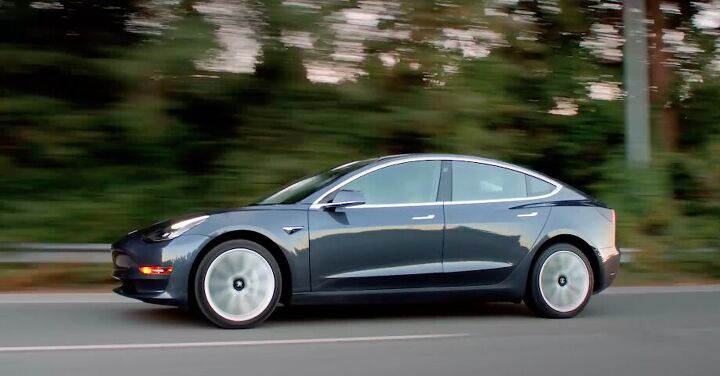Dual-motor Tesla Model 3 'Probably' Coming in July

It could happen, but then again, it may not. One thing’s for certain: buyers of the twin-motor Tesla Model 3 stand to wait less than those holding out for a base model.
In response to a Twitter user who asked when we can expect the all-wheel-drive variant of the massively hyped electric sedan (“My car has been sitting in the configuration for months waiting on it”), Tesla CEO Elon Musk replied with an approximate month. For this prediction to come true, Tesla must reach its second production target. It missed the first.
“We need to achieve 5k/week with Model 3 before adding complexity that would inhibit production ramp,” Musk tweeted. “So probably July.”
Actually, Tesla missed its first two Model 3 production targets — the first called for a production rate of 5,000 Model 3s per week by the end of 2017; the second, by end of the first quarter of 2018. Last week, the automaker reported that the week bridging March and April saw 2,020 Model 3s roll off the Fremont, California assembly line. The latest prediction was for 2,500/week by the end of Q1 2018.
For various reasons, including Musk’s claim of issues related to battery module assembly, the ramp-up of Model 3 production is taking longer than expected. Only pricier Long Range models have started production, with Musk previously telling reservation holders that the cheaper, $35,000 base models won’t see the assembly line until the end of 2018. His last prediction for dual-motor cars was mid-2018, so that goalpost hasn’t really changed.
Obviously, it makes more financial sense to get pricier variants into the driveways of buyers first, even if it means those who put $1,000 down on a base model when orders opened might have to wait close to two years to see production start. By then, the $7,500 federal tax credit will likely be halved.
Most reservations holders have no intention of buying the absolute cheapest base model once they’re invited to configure it online (options pile up fast), but that $35k sticker was awfully tempting. Given the level of devotion seen among the brand’s faithful, a mass exodus of reservation holders isn’t likely. Plus, rising production volumes, while still lower than expected, could help soothe budding frustrations. For some, anyway.
Cheat Sheet writer Eric Schaal isn’t among this group. Last week, he penned a column telling everyone exactly why he’s dumping his reservation.
[Image: Tesla]

More by Steph Willems
Latest Car Reviews
Read moreLatest Product Reviews
Read moreRecent Comments
- Add Lightness ...and I thought the Trump Towers were excessively pretentious.
- Daniel Tons of discounts out there on the eGMP's, just pick your style: Ionic 5/6, Kia EV6 and Genesis GV60. Personally, I got $20k off on a $60k MSRP GT-Line EV6 (only $7500 of that was a "rebate" from the state, the rest was Kia and dealer discounts). They are not only the same platform, but nearly identical mechanically other than slightly adjusted wheelbases. Find this one ugly? Look at Ionic 5 or EV6 instead, it's actually pretty cool how they came up with 4 distinct styles with basically the same car to fit many different tastes.
- Dave Holzman EVs will be ready for prime time when the chargers are dependable, and easy to use, when they can fill the battery in around 10-15 minutes, when there are sufficient numbers of them that people don't have to hang out for a half an hour waiting for a fast charger to be free, when chargers are widely available even in Nebraska, Wyoming, eastern Oregon, Nevada, Utah, the northern parts of Maine, New Hampshire, and Vermont, and within 10 miles of the start of the Tail of the Dragon, and when they get fixed pronto when they have problems.
- MaintenanceCosts The Supercharger network is something with much more growth potential than their actual car building operations, which has been marvelously run to this point and has a years-long head start on all its competitors, and Elon lays the whole team off?I don't know if it's distraction or the drugs, but he is not making good decisions and should not be CEO anymore.
- Dirk Wiggler I drive down the Palisades and near the George Washington Bridge I see FIAT housing complex (apartments, same font as the auto company). Seems like they tout energy/electric efficiency. I always wonder, 'what's that...is it really the same FIAT?'


































Comments
Join the conversation
Musk tweeted. “So probably July.” July 2019, 2020, or 2021?
Coming? Coming where? To a road? C'mon - really?!